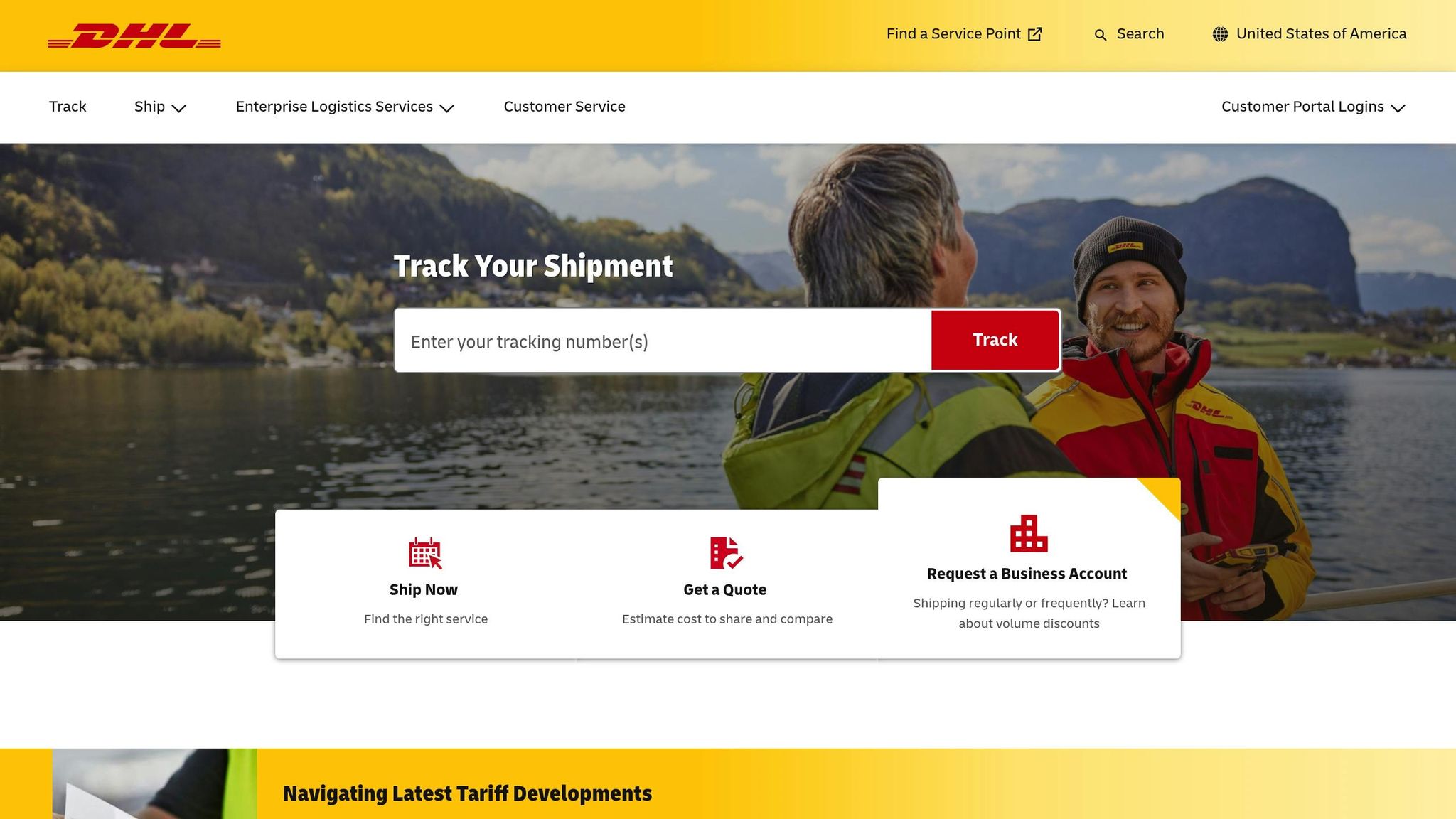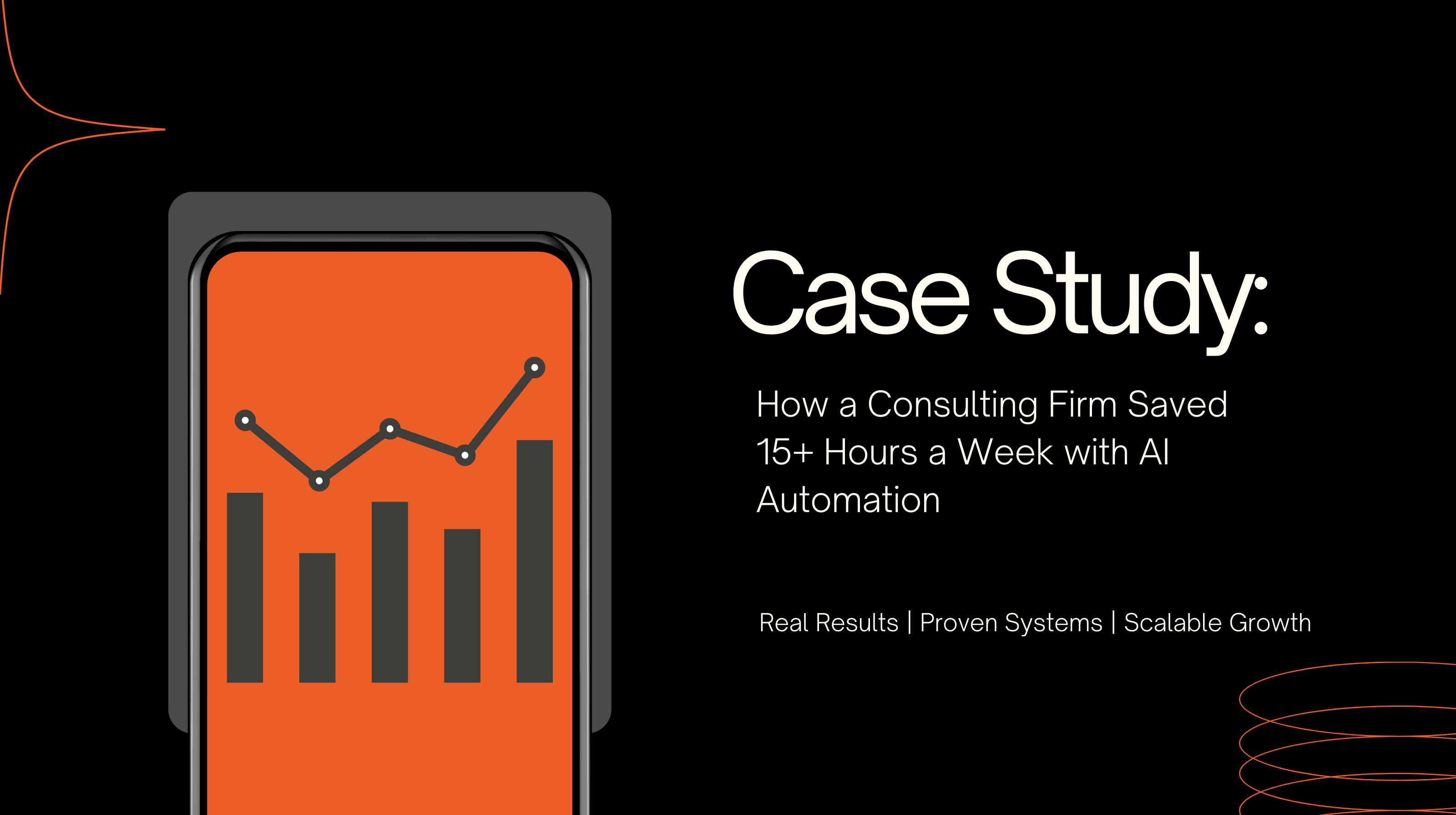Automation is reshaping business efficiency, saving time, reducing costs, and improving productivity. Companies are turning to custom automation to address specific challenges, streamline workflows, and scale operations. Unlike off-the-shelf solutions, custom systems are tailored to fit unique processes, ensuring better results and long-term flexibility.
Key Takeaways:
Examples:
By focusing on automating repetitive tasks, integrating systems, and leveraging AI, businesses can achieve faster results and higher ROI. Custom automation is no longer a luxury - it’s a key to staying competitive in today’s fast-paced market.
DHL Group: Process Automation for Global Business Services, Success Story - Bizagi Catalyst '21

Success Stories in Custom Automation
Examples from various industries highlight how custom automation can revolutionize business operations. These stories illustrate the tangible benefits of tailored automation solutions.
Retail: Streamlining Inventory Management
Anglia Cathodic Protection Services faced significant challenges as their workload grew, overwhelming their outdated paper-based systems. Inventory tracking was scattered across multiple locations, causing delays and inefficiencies. By adopting Q-Hub's custom automation solutions, they streamlined document management and improved non-conformance tracking. This resulted in a 40% reduction in maintenance response times across 12 retail locations.
Similarly, Rocal Insulating Panels experienced a 60% decrease in average maintenance resolution times after implementing comparable automation tools, which helped ensure smoother operations.
E-commerce: Enhancing Customer Service
Spotify began using robotic process automation in 2017, and today, the company operates over 100 bots. These bots save more than 45,000 work hours annually while creating an additional 24,000 hours of staff capacity.
In another example, a mid-sized financial services firm adopted Zoho ONE to optimize its CRM and customer service processes. The custom system automatically routed customer inquiries, cutting response times in half. AI-powered automation also managed 30–40% of routine inquiries. According to Salesforce, 74% of employees using automation report working faster, and 82% of sales teams say it allows them to focus on building stronger client relationships.
Logistics: Coordinating Workflows with Precision
DHL implemented automated logistics management tools to better coordinate shipments and track deliveries. This upgrade resulted in a 26% increase in on-time deliveries, thanks to improved workflows and fewer manual errors.
Meanwhile, Uber Freight embraced robotic process automation on a company-wide scale. Initially used for financial processes, the automation was later expanded to logistics coordination. Within three years, Uber Freight had over 100 automated processes in place, leading to annual savings of approximately $10 million.
Finance: Accelerating Data Processing
iPSL, a payment processing company, transformed its financial reporting by using Vena's automated Excel interface. This change reduced reporting timelines by 66%, shortening the process from six weeks to just 10 days.
Lacoste, the fashion retailer, automated its refund processing workflow with Pipefy. This innovation cut refund processing times by 50%, saving the company over 1,000 hours annually.
For 12five Capital, a banking and financial services firm, creating an internal operations app using Glide proved transformative. The custom app reduced approval times by 70% and boosted team productivity by 50%.
These stories consistently highlight how tailored automation solutions address specific business needs, delivering measurable improvements in efficiency and performance.
Automation Strategies That Deliver Results
Success stories across industries highlight three key automation strategies that can drive real, measurable outcomes. These approaches aim to tackle inefficiencies and create smoother workflows, transforming how businesses operate.
Automating Repetitive and Manual Tasks
One of the most immediate benefits of automation comes from eliminating tedious, manual tasks that eat into employee productivity. According to a 2020 McKinsey report, 31% of global businesses had fully automated at least one business function, while 66% were testing automation in specific processes.
Small businesses, in particular, can lose over 20 hours a week on repetitive tasks like payroll and marketing.
"Automating isn't about replacing people - it's about empowering small business owners to focus on what they do best, while letting technology handle the rest." - Burbity Workspaces
The key to successful automation lies in identifying and mapping workflows to locate bottlenecks. Clear goals - such as faster turnaround times or improved data accuracy - are crucial to measure the success of automation efforts. For example, in May 2023, Torch & Crown Brewing Company reduced their weekly workload by six hours by automating tip pooling.
Starting small is often the best approach. Automating simpler tasks first helps businesses build confidence before moving on to more complex processes. Standard operating procedures (SOPs) can also make integrating automation tools much smoother. Once these tasks are automated, the next step is connecting these systems for a seamless workflow.
Connecting Different Systems
Integrating systems eliminates data silos and reduces the need for manual transfers between departments. According to Gartner's 2024 report, businesses that adopt integration technologies often see operational improvements of 20% to 30% within their first year.
Take, for example, a mid-sized SaaS company that used Zapier to connect Slack and Google Workspace for onboarding. Whenever HR added a new employee, Slack sent a welcome message, Google Workspace accounts were created, and onboarding meetings were scheduled - all automatically. This setup saved the HR team over ten hours of work each week.
Research from MuleSoft shows that 92% of organizations consider integration essential for achieving their digital transformation goals. By 2027, it's estimated that over 65% of application development will rely on low-code platforms with robust API ecosystems.
To ensure successful integration, businesses should map out all tools and people involved, replace fragmented solutions with connected systems, and monitor performance regularly. Striking a balance between automation and human oversight is also vital to maintain efficiency without losing a personal touch.
Once systems are connected, the next step is leveraging AI to make smarter, faster decisions.
Using AI for Decision-Making
AI has the power to transform business operations by analyzing massive datasets and delivering insights in real time. By 2025, generative AI is expected to account for 10% of all data produced, and half of all businesses already use AI in at least two functions.
AI's strength lies in its ability to process data swiftly and without bias. In logistics, for example, AI systems can reroute vehicles around traffic based on weather conditions, inventory levels, and congestion, saving both time and fuel. Similarly, in warehousing, AI-powered robots can instantly determine the best storage locations for goods, significantly boosting efficiency.
Predictive analytics is another game-changer. Retailers can analyze historical sales data, customer preferences, and seasonal trends to forecast demand months in advance, helping them avoid overstocking or running out of inventory.
AI also delivers cost savings. It can reduce HR expenses by 17% and financial process costs by 80%, while minimizing errors. These benefits stem from AI's ability to analyze large volumes of data and provide actionable recommendations across various business functions.
McKinsey research predicts a surge in AI investments over the next three years. As businesses adopt AI, it will enable more personalized marketing, precise microtargeting, and better predictive analytics for supply chains and financial planning.
To make the most of AI, companies should focus on areas where data volumes are too overwhelming for human teams, such as quality control, customer service routing, and inventory management.
sbb-itb-d7ea0c6
Efficiency Gains Comparison
The numbers don't lie - custom automation has a proven track record of delivering impressive results across industries. By building on established automation strategies, businesses are unlocking measurable improvements in productivity, cost savings, and overall efficiency.
Efficiency Metrics Across Success Stories
Data from successful automation projects reveals consistent trends across various sectors. Manufacturing companies often see significant productivity boosts, while service industries frequently achieve notable reductions in labor costs.
These examples highlight the diverse benefits of automation:
"We wanted to integrate existing and new cells– Acieta listened to our needs and integrated our feedback into their design. They retrofitted the existing components and it ended up being a simplified and efficient operation, more operator friendly."
– Central United Corporation
In logistics, robotic process automation (RPA) helped a company cut shipment processing time from 48 hours to just 30 minutes, according to a Deloitte case study.
Healthcare organizations are also reaping the rewards. By adopting Intelligent Document Processing (IDP), one firm reduced errors in patient records by 80%, improving both operational efficiency and patient safety.
Retailers often see balanced improvements across multiple areas. For example, a global retailer that combined RPA with business intelligence tools accelerated decision-making by 25% and improved compliance accuracy by 15%.
Tracking key performance indicators (KPIs) has also proven to shorten the time to ROI. Businesses that monitor metrics closely often see returns within 9–12 months, compared to the 18+ months it might take without clear benchmarks.
Custom automation can even optimize physical space. For instance, Hytrol reduced its production square footage by nearly 80% by implementing automation solutions, while Cotterman consolidated multiple applications into one facility, saving on trucking and warehousing expenses.
"Since we've integrated Acieta automation, we've reduced our production square footage by almost 80%."
– Hytrol
The financial benefits of automation extend well beyond direct cost savings. Research from Forrester, McKinsey, and PwC shows that AI-driven automation can save $250,000 to $1 million per process, cut operational costs by up to 30%, and reduce errors by 50–75% .
These success stories demonstrate that custom automation isn't just about tackling repetitive tasks. It's about creating a ripple effect of time savings, cost reductions, and productivity gains that can transform entire operations.
Custom Automation Implementation Factors
The success stories we've explored highlight a common thread: companies that excel with custom automation take a thoughtful, strategic approach instead of rushing in without a plan. Addressing critical implementation factors can be the difference between a game-changing project and an expensive mistake. Here are the key elements to focus on to ensure your automation efforts deliver tangible operational improvements.
Finding Process Bottlenecks
Before diving into automation, it’s crucial to assess your operations and identify bottlenecks. The goal isn’t to automate everything - it’s to target processes where automation will make the biggest impact. Start by mapping workflows and tracking key performance indicators (KPIs) like wait times or backlog volumes .
Tools such as Kanban boards and cumulative flow diagrams can provide real-time visibility into areas where work piles up. Don’t overlook the insights of your frontline employees - they often spot inefficiencies that raw data misses. Regular audits and open communication are essential to uncover and address these bottlenecks. This targeted approach plays a significant role in achieving the operational improvements seen in our case studies.
Planning for Growth and Integration
Long-term success with automation depends on designing systems that can grow with your business and integrate smoothly with your existing tools. Start with compatibility checks and use APIs, middleware, or cloud-based platforms to create scalable systems that avoid data silos.
"Automation should be approached as a transformative process rather than a quick fix." - CEO of Cantey Tech Consulting
Thorough testing is essential to ensure everything works seamlessly, and strong data governance practices are critical for maintaining accuracy and security. Companies often rely on native integrations, custom APIs, or third-party platforms to achieve these goals. Research shows that organizations using custom applications can boost productivity by up to 25% and reduce manual processes by 30%.
Working with Automation Specialists
Technical challenges can be complex, which is why partnering with experienced automation specialists is so valuable. These experts bring the knowledge and tools needed to tackle integration issues and ensure your project succeeds. Take Devcore, for example. Their Leverage Blueprint™ framework focuses on identifying and resolving operational inefficiencies, delivering tailored solutions that meet specific business needs. Whether it’s managing repetitive tasks, leveraging AI for decision-making, or integrating software systems, their approach ensures measurable results.
Studies back up the importance of working with specialists, showing higher project success rates and reduced costs when experts are involved. Specialist firms also excel in gathering requirements - a critical step, as 42% of projects fail due to poor requirements - and provide ongoing training and support. Within six months, businesses often see a 20% productivity boost from these collaborations. Custom systems can cut operational costs by as much as 30%, while off-the-shelf solutions frequently lead to higher expenses due to updates and customization needs.
When choosing an automation partner, look for those who prioritize measurable outcomes and foster continuous improvement. The best partners don’t just build robust systems; they also help your team develop the skills needed for ongoing success.
Conclusion: How Custom Automation Improves Business Efficiency
The data makes it clear - when applied thoughtfully, custom automation can bring about dramatic improvements in business operations. Companies using automation technologies report cutting process costs by 30% to 50%. Even more impressive, 73% of businesses experience positive ROI within just 30 days when they automate the right tasks.
The potential for quick returns is striking. Take, for instance, a consulting firm that saw an 800% ROI in just 30 days by automating how client inquiries were routed. Similarly, an e-commerce retailer achieved a 1,005% ROI while significantly reducing data entry mistakes. On average, businesses targeting high-impact processes see a 312% ROI in the first month, with top-performing automations paying for themselves in as little as 8 days.
Custom automation doesn’t just save money - it scales operations efficiently. It allows businesses to handle more work without the associated rise in costs, all while improving accuracy and minimizing waste. For example, a manufacturing company automated its supplier invoice processing, cutting processing time by 75%, reducing payment discrepancies by 88%, and capturing $1,200 more each month in early payment discounts. These kinds of improvements directly address specific operational hurdles.
What sets custom automation apart is its ability to meet unique business needs that generic, off-the-shelf solutions simply can’t. This is especially important as businesses grow. Nearly 90% of workers report that automation tools make them more productive, and 80% say these tools free up time for more valuable activities, such as building stronger customer relationships or learning new skills. This adaptability provides a long-term edge in competitive markets.
Investing in custom automation lays the groundwork for sustainable growth. Companies that embrace tailored solutions are better equipped to handle increasing complexity, meet growing customer expectations, and stay ahead in fast-changing markets. With quick-win automations implemented in as little as 2 to 14 days and success rates as high as 89% for carefully chosen projects, the question isn’t whether to automate - it’s how soon you can start. These results highlight that custom automation is a powerful tool for achieving lasting operational success.
"The marriage of automation and scalability helps you create a flexible and resilient framework that can adapt to changing business landscapes. In doing so, you're building a foundation that supports not just growth but thriving expansion."
FAQs
How can custom automation be designed to meet my business's specific needs?
Custom automation is designed to fit seamlessly into your business's unique workflows, addressing your specific processes and objectives. By taking a close look at how your operations function, these solutions are crafted to simplify tasks, minimize errors, and ensure adherence to industry standards.
These systems can manage a variety of needs, from automating repetitive tasks to incorporating sophisticated tools for decision-making or improving customer service. The outcome? A tailored, efficient solution that helps save time, reduce expenses, and boost productivity - all built with your business in mind.
What are the long-term advantages of using custom automation instead of off-the-shelf solutions?
Custom automation delivers personalized solutions that align perfectly with your business's unique requirements. Unlike generic, off-the-shelf options, custom automation offers better scalability, adaptability, and security. By addressing specific workflows and challenges, it helps reduce errors, cut down on waste, and make the most of your resources - ultimately boosting efficiency and lowering operational costs over time.
What’s more, custom systems empower businesses to respond swiftly to shifting market demands, helping them stay ahead of the competition. Designed with growth in mind, these solutions evolve alongside your organization, ensuring they remain valuable as your business expands and changes.
What steps can businesses take to ensure smooth integration and scalability when adopting custom automation systems?
To make sure custom automation systems work seamlessly and can scale effectively, businesses need to focus on a few critical aspects. First, ensure compatibility with existing tools to avoid disruptions. Second, implement strong error-handling mechanisms to address issues as they arise. Lastly, establish clear validation processes to keep data accurate and reliable.
It’s also smart to design systems with growth in mind. Using flexible architectures like microservices and adopting cloud-based solutions can help your systems scale as your business expands.
On top of that, regular performance monitoring and load testing are essential. These practices help identify bottlenecks early, so you can address them before they become major problems. By following these strategies, businesses can improve efficiency, streamline operations, and set the stage for sustainable growth.
Related posts
- Ultimate Guide to Scaling Business with Automation
- 5 CRM Automation Success Stories
- How Computer Vision Improves Quality Control Processes
- Real-Time Data Sync with AI: What to Know
{"@context":"https://schema.org","@type":"FAQPage","mainEntity":[{"@type":"Question","name":"How can custom automation be designed to meet my business's specific needs?","acceptedAnswer":{"@type":"Answer","text":"<p>Custom automation is designed to fit seamlessly into your business's unique workflows, addressing your specific processes and objectives. By taking a close look at how your operations function, these solutions are crafted to simplify tasks, minimize errors, and ensure adherence to industry standards.</p> <p>These systems can manage a variety of needs, from automating repetitive tasks to incorporating sophisticated tools for decision-making or improving customer service. The outcome? A tailored, efficient solution that helps save time, reduce expenses, and boost productivity - all built with your business in mind.</p>"}},{"@type":"Question","name":"What are the long-term advantages of using custom automation instead of off-the-shelf solutions?","acceptedAnswer":{"@type":"Answer","text":"<p>Custom automation delivers <strong>personalized solutions</strong> that align perfectly with your business's unique requirements. Unlike generic, off-the-shelf options, custom automation offers better <strong>scalability, adaptability, and security</strong>. By addressing specific workflows and challenges, it helps reduce errors, cut down on waste, and make the most of your resources - ultimately boosting <strong>efficiency</strong> and lowering <strong>operational costs</strong> over time.</p> <p>What’s more, custom systems empower businesses to <strong>respond swiftly</strong> to shifting market demands, helping them stay ahead of the competition. Designed with growth in mind, these solutions evolve alongside your organization, ensuring they remain valuable as your business expands and changes.</p>"}},{"@type":"Question","name":"What steps can businesses take to ensure smooth integration and scalability when adopting custom automation systems?","acceptedAnswer":{"@type":"Answer","text":"<p>To make sure custom automation systems work seamlessly and can scale effectively, businesses need to focus on a few critical aspects. First, ensure compatibility with existing tools to avoid disruptions. Second, implement strong error-handling mechanisms to address issues as they arise. Lastly, establish clear validation processes to keep data accurate and reliable.</p> <p>It’s also smart to design systems with growth in mind. Using flexible architectures like microservices and adopting cloud-based solutions can help your systems scale as your business expands.</p> <p>On top of that, regular performance monitoring and load testing are essential. These practices help identify bottlenecks early, so you can address them before they become major problems. By following these strategies, businesses can improve efficiency, streamline operations, and set the stage for sustainable growth.</p>"}}]}




